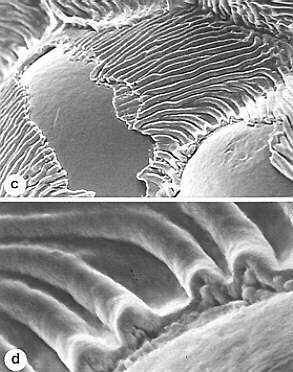"a: Isodiametrical cells in the seed coat of a cactus species (Matucana spec.). The tremendously developed cuticle is convoluted and displays the basic type of angiosperm folding. The parallel folds cross the cell borders at a right angle (a so-called anticlinal area). In the central area are the folds arranged differently. Cuticle folds are a feature of tendency of all angiosperms and are refined to this group. b: The upper surface of a ligulate flower of a yellow chamomile (Anthemis tinctoria, Compositae). Nearly parallel folding of the cuticle. These cuticle folds have several functions: they enhance the intense velvet effect of the flower color, increase the water-repellent quality of the flower surface, strengthen the stability of the petals and finally does it seem as if they could be recognized by landing pollinators. It supplies the insects with an additional information concerning the 'right' landing strip. (W. BARTHLOTT, N. EHLER, 1977, W. BARTHLOTT; 1981)



Epidermal surface of a cactus seed coat (Aztekium spec.). Upper picture c: Part of the cuticle has been blow away by ultrasound after a preceding treatment with pectinases. Lower Picture d: A detail of the structure shown above. The even thickness of the cuticle is clearly recognizable. It is arranged in a system of hollow folds that cover the smooth, unstructured cell walls of the epidermal surface. The two photos elucidate the organization of a complex cuticle. (W. BARTHLOTT, N. EHLER, 1977, W. BARTHLOTT, 1981)